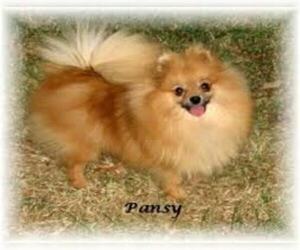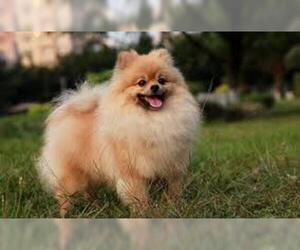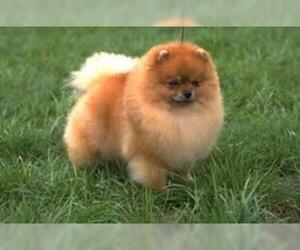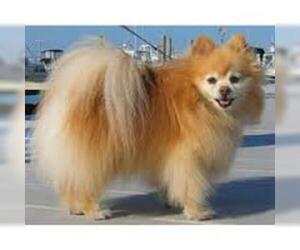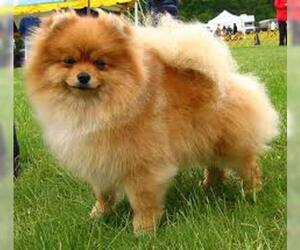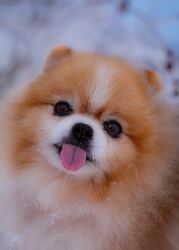
All about Pomeranian dog breed
A.K.A. :Pom, Pom Pom, Pommy, Dwarf Spitz, Toy Spitz, German Toy, Mini Spitz, Pom Pup, Fluffy Pom, Pocket Pom, Pom Companion, Royal Pom, Pom Fluff, Pomster, Pom Prince, Pom Princess
Size
Grooming requirements
Exercise requirements
Good with other dogs
Watchdog ability
Energetic
Training requirements
Playful
Affectionate
Good with other pets
Good with children
Good with strangers
Winter
Summer
Healthiness
Protective
Life Span
| Pure Breeds | Member |
| Breeds A - Z | P |
| Breeds by Group | Companion Toy |
| Breeds by Trait | Hypoallergenic Low Shedding Smartest Dog Breeds |
| Overview: | The Pomeranian is a vivacious and charming toy breed, originating from the historic region of Pomerania, now part of Poland and Germany. Descended from larger Spitz-type dogs, they were miniaturized over generations, becoming beloved companions. Physically, they are recognizable by their luxurious double coat, often seen in striking shades like orange, cream, or black, and their distinctive foxy face with bright, alert eyes. Despite their small stature, Poms possess a bold and inquisitive temperament; they are intelligent, eager to please, and can be surprisingly independent. They adapt well to apartment living due to their size, though they still benefit from regular walks and mental stimulation. While generally good with older, respectful children, their delicate build makes them more suitable for families who understand their needs. Regarding health, Poms can be prone to patellar luxation, tracheal collapse, and dental issues, emphasizing the importance of responsible breeding and regular veterinary care to ensure a long, happy life. |
F.A.Q.
All You Need to Know About the Pomeranian Breed
The Pomeranian, a vibrant toy breed originating from the Pomerania region (now Germany and Poland), is renowned for its foxy expression, plumed tail, and luxurious double coat. Despite their small size, Pomeranians possess a bold, intelligent, and lively temperament, often described as "big dogs in a small package." They are generally affectionate and loyal companions, thriving on human interaction. Their compact size makes them ideal for apartment living, and while they can be good with respectful older children, early socialization is crucial for harmonious family integration. Regular, moderate exercise—like daily walks and indoor play—keeps them happy. Grooming is essential; their thick coat requires frequent brushing (2-3 times weekly) to prevent matting. Common health concerns include luxating patella, tracheal collapse, and dental issues, making regular vet check-ups important for these delightful, long-lived companions. Potential owners should research reputable breeders to ensure a healthy Pomeranian.Pomeranian Weight: Average Size & Healthy WeightThe average healthy weight for an adult Pomeranian is 3 to 7 pounds.While there can be slight variations, both male and female Pomeranians typically fall within this range. It's important to aim for a healthy weight for Pomeranian to ensure their well-being.
Curious about the Pomeranian height and how tall these fluffy companions typically get? Here's what you need to know about their average size:
The average height of a Pomeranian, measured at the shoulder (from the ground to the top of the shoulder blades), is generally between 6 to 7 inches tall.While 6-7 inches is the typical range, it's not uncommon to see slight variations. Some Pomeranians might be a little shorter, around 5 inches, while others can reach up to 8 inches. This variation can depend on several factors, including:- Individual Genetics: Just like people, individual dogs within a breed can have slight genetic differences affecting their final size.
- Gender: While not a drastic difference, male Pomeranians tend to be at the higher end of the height range, sometimes being an inch taller than females on average. However, this is not always the case, and many females can also reach the upper end of the spectrum.
Pomeranians boast an incredibly diverse range of Pomeranian colors, making each one unique! While many are AKC recognized Pomeranian colors, others are rarer. Common and AKC-accepted shades include orange (the most well-known), sable (a darker tipped coat over a lighter base), cream, white (pure white, no cream), black, brown (ranging from light to dark chocolate), and red. Patterns like brindle (stripes), parti (two or more colors, with one being white), and tri-color (black, white, and tan points) are also AKC-recognized. Beyond these, you'll find rare coat types and exotic Pomeranian variations such as blue (a dilute black, often appearing silvery-grey), lavender/lilac (a dilute chocolate, often with pinkish undertones), and merle (a marbled pattern, though merle is not accepted by the AKC). Pricing can vary significantly based on these Pomeranian colors and their rarity.
The Pomeranian personality is often described as bold, vivacious, and highly intelligent. Despite their small size, they possess a confident and sometimes feisty demeanor. They are generally very friendly and loyal to their families, often forming strong bonds. Pomeranians are adaptable and can be quite sociable, enjoying interactions with people and other pets when properly socialized from a young age. Their small stature makes them exceptionally well-suited for apartment living, though they still require regular exercise and mental stimulation. With children, they can be good companions, but due to their delicate size, supervision is crucial to ensure gentle interactions. Similarly, with other pets, they can coexist peacefully, especially if raised together, though their confident nature might lead them to assert themselves even with larger animals. They are alert and make excellent watchdogs, often barking to signal new arrivals or unusual sounds. Early training and socialization are key to nurturing a well-behaved and well-adjusted Pomeranian, bringing out their best temperament of Pomeranian traits.
Pomeranian Temperament & Personality Traits
The Pomeranian temperament is often described as bold, vivacious, and highly intelligent, making them excellent companion dogs. They are generally very friendly and sociable with their families, showing immense loyalty and affection. Despite their small size, they possess a big dog attitude, often unaware of their diminutive stature.Adaptability is a key trait; Pomeranians are well-suited for apartment living due to their compact size and moderate exercise needs, though they do enjoy outdoor play. They thrive on human companionship and can be prone to separation anxiety if left alone for extended periods.Regarding behavior with children, Pomeranians can be good with older, respectful children who understand how to interact gently with a small dog. However, due to their delicate build, supervision is crucial with very young children to prevent accidental injury. They may also be prone to nipping if startled or mishandled.Their sociability with other pets can vary. With proper socialization from a young age, they can coexist peacefully with other dogs and even cats. However, their bold nature might lead them to challenge larger dogs, so careful introductions and supervision are important.Pomeranians can exhibit tendencies towards stubbornness, especially during training, due to their independent streak. Consistency, positive reinforcement, and patience are essential. They are also quite sensitive to their owner's emotions and tone of voice, responding best to gentle guidance rather than harsh reprimands. They are known for being alert and can be prone to excessive barking if not trained to manage it, making them good little watchdogs.Pomeranian Care: Essential Daily Maintenance & Health TipsPomeranian care involves dedicated attention to their specific needs. Grooming needs are significant due to their double coat. Expect daily brushing to prevent mats and reduce shedding, with professional grooming every 4-8 weeks for tidiness and to manage coat health. Exercise limitations mean they are a low-energy dog breed. Short, daily walks (15-30 minutes) and indoor play are usually sufficient. Avoid over-exercising in extreme temperatures.Dietary considerations require high-quality small-breed dog food. Monitor portion sizes closely to prevent obesity, a common health concern. Due to their brachycephalic (short-nosed) anatomy, climate sensitivity is crucial. Pomeranians are prone to overheating; avoid strenuous activity in hot or humid weather and always provide fresh water and shade. Conversely, their small size makes them sensitive to cold, so provide warmth in chilly climates.Unlike breeds with pronounced folds, wrinkle and ear cleaning is minimal for Pomeranians. Check ears weekly for redness or odor and clean with a vet-approved solution if needed. Focus instead on dental care for Pomeranian; daily brushing is highly recommended to prevent periodontal disease, a very common issue in small breeds. Regular veterinary dental cleanings are often necessary.Common health concerns include Luxating Patella, Tracheal Collapse, and Hypothyroidism. Skin issues can arise from improper grooming or allergies. Weight management is paramount to prevent strain on their delicate joints and internal organs. Regular vet check-ups are vital for early detection and prevention. How to care for a Pomeranian truly involves consistent grooming, appropriate exercise, a balanced diet, and proactive health monitoring.
Pomeranian Activity Level: How Active Are Pomeranians?The Pomeranian activity level is generally moderate, balancing short bursts of playful energy with significant periods of rest. Despite their small size, Pomeranians are lively and curious, but they don't require the extensive exercise needs of larger, high-endurance breeds.Typically, a Pomeranian needs 20-30 minutes of daily exercise, broken into shorter sessions. This can include a brisk walk around the neighborhood, supervised playtime in a secure yard, or engaging indoor games like fetch. They thrive on mental stimulation and enjoy learning tricks, which also contributes to their overall activity.Due to their brachycephalic (short-nosed) anatomy, Pomeranians are prone to overheating and respiratory issues, especially in warm weather or during strenuous activity. Therefore, their exercise should be monitored carefully, and activities should be kept brief and at a moderate pace. They are not suited for long-distance running or intense outdoor sports.Pomeranians love playtime and interactive games with their owners. They enjoy chasing toys, exploring new scents on walks, and being the center of attention during play sessions. However, they are also content to curl up on the couch for long naps, making them adaptable to various household dynamics.This breed can be suitable for both active families who understand their limitations and low-energy households. For active families, they can participate in shorter, less intense activities. For less active individuals, their moderate exercise requirements are easily met, and they are happy to be lap companions for extended periods. Understanding a Pomeranian's exercise needs is key to a happy, healthy companion.
Pomeranians are also susceptible to allergies, which often manifest as itchy skin, ear infections, or excessive licking. Their thick coat can trap moisture and debris, increasing the risk of skin fold infections and fungal conditions if not properly groomed. Due to their dense fur and small size, they are highly vulnerable to heat sensitivity, making hydration, shade, and temperature control essential during warm weather or indoor heating.
Breed Breakdown: What Experts Say About the Pomeranian
Rating the "Size" trait of the Pomeranian breed, I'd give it a 2.This rating reflects the Pomeranian's distinctly diminutive stature. They typically weigh between 3 to 7 pounds and stand around 6 to 7 inches tall, placing them firmly in the toy breed category. Their delicate bone structure and compact body further emphasize their small dimensions. When compared to other companion dogs, even other small breeds like Chihuahuas or Yorkshire Terriers, Pomeranians are often on the smaller end of the spectrum. Their tiny size makes them exceptionally well-suited for apartment living, as they require very little space. They are also excellent travel companions due to their ability to fit comfortably in carriers that meet airline cabin requirements, and their minimal space needs make them ideal for households with significant space constraints.
I would rate the Pomeranian's "Grooming Requirements" at a 7 out of 10, leaning towards high-maintenance.While they don't have the extensive skin folds or the extreme bathing frequency of some breeds, their luxurious double coat is the primary driver of this rating. It requires consistent and thorough brushing, ideally several times a week, to prevent matting and tangles, which can quickly become painful and lead to skin irritation. They are moderate to heavy shedders, especially during seasonal changes, so regular brushing also helps manage loose fur. While not prone to excessive earwax, routine ear checks and cleaning are still necessary. Nail trimming is crucial and needs to be done frequently, as overly long nails can cause discomfort and impact their gait. Bathing, while not daily, is needed every few weeks to keep their coat clean and healthy, and their fur takes time to dry completely. While generally healthy, their dense coat can sometimes mask skin issues, making regular grooming important for early detection. Compared to a short-haired, low-shedding breed, Pomeranians definitely demand more frequent and dedicated grooming sessions.
I would rate the Pomeranian's exercise requirements at a 3 out of 10. While they are energetic and playful, their small size and brachycephalic nature mean their physical demands are relatively low. They thrive with daily short walks and indoor playtime, enjoying bursts of activity rather than sustained exertion. Excessive or strenuous exercise can be detrimental due to their delicate respiratory system, making them unsuitable for activities requiring long periods of high-intensity movement. They are content with moderate daily activity to stay healthy and mentally stimulated, and do not require structured, demanding routines.
I'd rate the Pomeranian's "Watchdog Ability" a 7 out of 10.While their small stature might suggest otherwise, Pomeranians are surprisingly effective as household watchdogs, primarily due to their exceptional alertness and consistent barking behavior. They are highly attuned to their environment and possess strong territorial instincts, often considering their home and family as their domain to protect. Any unfamiliar sound, a knock at the door, or the sight of a stranger approaching will almost invariably trigger a rapid and persistent volley of barks. This isn't just yappy, indiscriminate noise; it's a clear warning signal. While they lack the physical presence to *physically* deter an intruder, their persistent barking is more than capable of providing meaningful early warnings. This makes them excellent at alerting their human companions to potential threats, making them more than just a passive companion – they are a very capable early warning system.
I would rate the Pomeranian's "Good with Other Dogs" trait a 6 out of 10.Pomeranians, while generally not inherently aggressive, often possess a strong sense of self-importance and can be quite assertive, sometimes even bossy, with other dogs, regardless of size. Their small stature can sometimes lead to a "big dog in a little body" syndrome, where they are unafraid to challenge larger dogs. This isn't necessarily aggression, but it can be perceived as such and might lead to friction if the other dog isn't tolerant.They thrive in canine company when properly socialized from a young age, but without it, they can develop a "small dog syndrome" where they are either overly fearful or overly dominant. They often prefer the company of other small, similarly playful dogs but can coexist with larger, more mellow breeds if the larger dog is gentle and respectful of the Pom's space. However, their high energy and tendency to bark can sometimes annoy more placid dogs. Introductions to new dogs should always be supervised and controlled, as they might not back down from a challenge. While they can adapt to multi-dog households, their strong personalities mean they may try to be the "alpha" regardless of their size, requiring consistent training and management to ensure peaceful coexistence. They are not typically a breed that will instantly bond with any dog they meet; careful introductions and ongoing socialization are key to them being truly "good" with other dogs.
I would rate the Pomeranian's "Energetic" trait a 7 out of 10.Pomeranians, despite their small size, possess a surprisingly vivacious and energetic personality. They are far from being a laid-back "lap warmer" and are naturally active, enjoying playful interactions and short bursts of enthusiastic activity. Their playfulness is a key characteristic, and they love to engage with toys and their human companions. They do have a genuine need for daily physical stimulation to keep them happy and well-behaved, typically enjoying a couple of short walks or active play sessions each day. While they have decent endurance for their size, their brachycephalic (short-nosed) anatomy is a significant factor. This can limit their stamina and exercise tolerance, especially in hot weather or during prolonged, intense activity. They are generally not suited for long-distance running or highly strenuous athletic activities like some other breeds, as their breathing can be compromised. Therefore, while they are certainly energetic and enjoy being active, their physical limitations prevent them from reaching the extremely high energy levels of, for example, a border collie. They thrive on consistent, moderate activity rather than extended, demanding exercise.
I'd rate the "Training Requirements" of the Pomeranian breed a 6 out of 10. While intelligent and capable of learning a wide array of commands and tricks, their charming personalities often come with a significant dollop of stubbornness and a relatively short attention span, especially as puppies. They are highly responsive to positive reinforcement and food-motivated, which are excellent tools for training, but consistency is absolutely paramount. Without it, Poms can quickly develop what's affectionately known as "small dog syndrome," becoming demanding and less respectful of boundaries. They can be prone to nuisance barking if not taught proper quiet commands, and their independent streak means they'll test your resolve. While a determined beginner can certainly succeed, a Pomeranian isn't a "set it and forget it" breed; they definitely require structured routines and a firm, consistent hand, making them more suited for owners who are committed to ongoing training and can dedicate time to reinforcing good behavior.
I'd rate the "Playful" trait of the Pomeranian breed a solid 9 out of 10.Pomeranians are undeniably spirited and embody a delightful, effervescent zest for life. Their typical activity level is surprisingly high for such a small dog; they are not content to simply lounge about all day. They absolutely adore games and interaction, often initiating play themselves by pouncing, nipping playfully, or bringing toys. Their attention-seeking behavior is quite prominent, as they thrive on being the center of their human's world and will employ a variety of charming antics to achieve this. They respond to toys and playtime with an almost boundless enthusiasm, chasing, shaking, and "killing" their toys with great theatrical flair. Overall, their enthusiasm in daily life is infectious – they greet each new experience with a curious and joyful attitude, making them one of the most naturally spirited and fun-loving companion dogs, far from laid-back.
I would rate the Pomeranian's "Affectionate" trait a 9 out of 10.Pomeranians are renowned for their intense devotion to their human companions. They possess a profound desire for human companionship and often form strong bonds with their primary caregiver, though they extend their affection to the entire family. Physical closeness is a hallmark of the breed; Poms are quintessential lapdogs, thriving on cuddling, snuggling under blankets, and will often insinuate themselves into any available lap. Their loyalty is unwavering, and they are highly sensitive to their owner's emotions, often offering comfort or mirroring their owner's mood. It's common for a Pom to become a "velcro dog," following their family members from room to room, preferring to always be in the same vicinity. They absolutely thrive on affection and attention, often becoming distressed if left alone for extended periods. While small in stature, their need for connection is immense, making them far from independent and much more dependent on constant human interaction and love compared to many other companion breeds.
I would rate the Pomeranian's "Good with Other Pets" trait as a 6 out of 10.While Pomeranians are generally not aggressive, their small size and sometimes feisty personality can lead to a mixed bag when it comes to coexisting with other animals. They tend to be more compatible with other dogs, especially those of similar size or temperament, and can form strong bonds. However, their instinct to assert themselves, despite their miniature stature, can sometimes lead to them bossing around larger, more placid dogs. Their prey drive is typically low, making them less likely to view cats as prey, but their sometimes yappy nature and desire to be the center of attention can annoy felines. Resource guarding, particularly over food, toys, or their human, can be a moderate concern if not addressed early. Early and consistent socialization is crucial for a Pomeranian to be genuinely pet-friendly; without it, they can become possessive and yappy, which can be disruptive in a multi-pet household. They are adaptable, but their success in a multi-pet environment heavily relies on proper introductions, ongoing training, and consistent supervision to ensure peaceful coexistence and prevent their sometimes-overconfident demeanor from causing issues. They require their humans to actively manage interactions rather than being naturally harmonious with all other animals without intervention.
The Pomeranian, while undeniably charming, rates a 3 out of 10 for the "Good with Children" trait. They are generally not the ideal breed for families with young children.Pomeranians possess a delicate bone structure and a somewhat assertive temperament in a tiny package. They can be easily injured by unintentional rough handling, even from well-meaning toddlers. Their patience is often limited, and they can become snappy or fearful if startled, poked, or treated like a toy. Their natural inclination is not towards boisterous play, and they generally prefer a quieter, more predictable environment. While they can be affectionate with their trusted adult owners, this affection doesn't always extend to rambunctious children. They often don't tolerate high noise levels well and can become anxious or defensive in such situations. While training and careful supervision are absolutely essential to ensure a safe environment for both the dog and the children, their inherent nature makes them more suited for homes with older, respectful children who understand how to interact gently with a small, fragile dog, or ideally, an adult-only household. They are not naturally gentle and affectionate with children; rather, their interaction requires constant management and education of both the child and the dog.
Pomeranians generally rate around a 5 or 6 for "Good with Strangers." They aren't inherently aggressive or unfriendly, but they're typically not the type to greet every new person with an open paw and wagging tail either. Their small size and often alert nature mean they can be prone to barking at unfamiliar faces or sounds, acting as tiny but mighty watchdogs. While they can be very devoted to their family, they often approach strangers with a degree of caution or reserve. Early and consistent socialization is crucial for a Pomeranian to be comfortable and polite in public or around guests; without it, they can become quite wary and yappy. They're more likely to observe newcomers before deciding to approach, rather than being naturally outgoing from the start.
The Pomeranian breed rates a 2 out of 10 for winter tolerance. Their thick double coat, while initially suggesting warmth, is surprisingly inadequate for anything beyond very mild cold. Their extremely small size means they have a high surface area to volume ratio, leading to rapid heat loss. They also lack significant body fat for insulation.Compounding these issues is their brachycephalic anatomy, which can make breathing more difficult in cold, dry air, potentially leading to respiratory distress. They are highly susceptible to hypothermia, even in moderately cold temperatures. Safely enjoying outdoor activities in cold climates is severely limited; brief potty breaks in very cold weather are often the extent of their comfort. Compared to many other companion dogs, Pomeranians absolutely require special care during winter months, including warm sweaters or coats for any outdoor exposure, diligent monitoring for signs of shivering or distress, and primarily indoor activities to keep them warm and safe.
I would rate the Pomeranian's "Summer" tolerance at a 2.Pomeranians possess several characteristics that make them highly susceptible to heat. Their luscious double coat, while beautiful, acts as excellent insulation, trapping heat and making it difficult for them to cool down. Furthermore, as a slightly brachycephalic breed, their shorter snout can compromise their ability to pant efficiently, which is a primary mechanism for canine thermoregulation. This anatomical feature, combined with their dense coat, significantly increases their risk of heatstroke, even in moderately warm temperatures. They are not dogs that can safely tolerate prolonged outdoor activity during summer months. In fact, even short walks on hot pavement can lead to overheating. Compared to many other companion dogs, Pomeranians absolutely require special care in summer, including strict climate control, avoidance of direct sunlight, limited outdoor exposure to early mornings or late evenings, and constant access to fresh water. They are far more prone to heat-related illnesses and require a much more cautious approach to warm weather than many other breeds.
I would rate the Pomeranian's "Healthiness" trait a 6 out of 10.Pomeranians, while generally a robust and lively breed for their size, do have a notable number of genetic predispositions and breed-specific health issues that prevent them from being considered exceptionally healthy. Their short snouts can lead to breathing difficulties, particularly in warmer weather, and they are prone to luxating patellas (slipping kneecaps), a common problem in many small breeds. Dental disease is also a significant concern due to their small mouths, often requiring regular professional cleanings. Other issues include collapsing tracheas, alopecia X (black skin disease), and occasionally heart conditions like patent ductus arteriosus.However, their life expectancy is quite good, often ranging from 12 to 16 years, which is a testament to their overall resilience when well cared for. Responsible breeding practices play a crucial role in mitigating many of these issues, with breeders screening for conditions like luxating patellas. With diligent preventive care, including regular vet check-ups, dental hygiene, and a balanced diet, Poms can live long, healthy lives. They are not typically considered high-maintenance in terms of overall health compared to some brachycephalic breeds, but they do require attentive owners who are aware of their specific vulnerabilities. They are generally more robust than some toy breeds but require more vigilance than a truly "hardy" mixed-breed dog.
I'd rate the "Protective" trait of the Pomeranian breed a 7 out of 10.Pomeranians are surprisingly alert and possess a keen sense of hearing, making them excellent little alarm systems. Their territorial instincts are strong, and they're quick to voice their disapproval with a surprisingly loud bark when strangers approach their home or perceived territory. This loyalty to their owners is unwavering, and they will definitely stand their ground, albeit a very small patch of ground, to warn against perceived threats. They are highly reactive to strangers, often barking persistently until they are acknowledged or the "threat" moves on. While they are phenomenal watchdogs in the sense of alerting you to anything amiss, they are absolutely *not* guard dogs. Their small size and lack of physical prowess mean they are incapable of offering any meaningful physical protection in a household setting beyond being a very enthusiastic noise-maker. Their protective nature stems from their alert, vocal, and loyal temperament, making them ideal companion dogs who will always let you know if someone is at the door, but never a physical deterrent.
I would rate the Pomeranian's "Life Span" trait an 8 out of 10.Pomeranians are considered a long-lived breed compared to many other companion dogs. Their average life expectancy typically ranges from 12 to 16 years, with many individuals living even longer with proper care. While they do have some genetic predispositions like patellar luxation, tracheal collapse, and certain eye conditions, these are often manageable and do not universally shorten their lifespan. Responsible breeding practices play a significant role in mitigating the prevalence of these issues, and their small size generally contributes to less stress on their joints and organs compared to larger breeds. With good nutrition, regular veterinary care, and an active lifestyle, Pomeranians generally enjoy a remarkably long and healthy life.
Pomeranian Puppies for saleSee all puppies for sale
Pomeranian Dogs for adoptionSee all dogs for adoption
Pomeranian BreedersSee all breeders
Similar Dog Breeds for Pomeranian
Breed Mixes of Pomeranian
Quick Breed Selector 0 - not important, 1 - smallest, 10 - largest
Variants & Mistakes :Pommeranian, Pommeranion, Pommeranien
